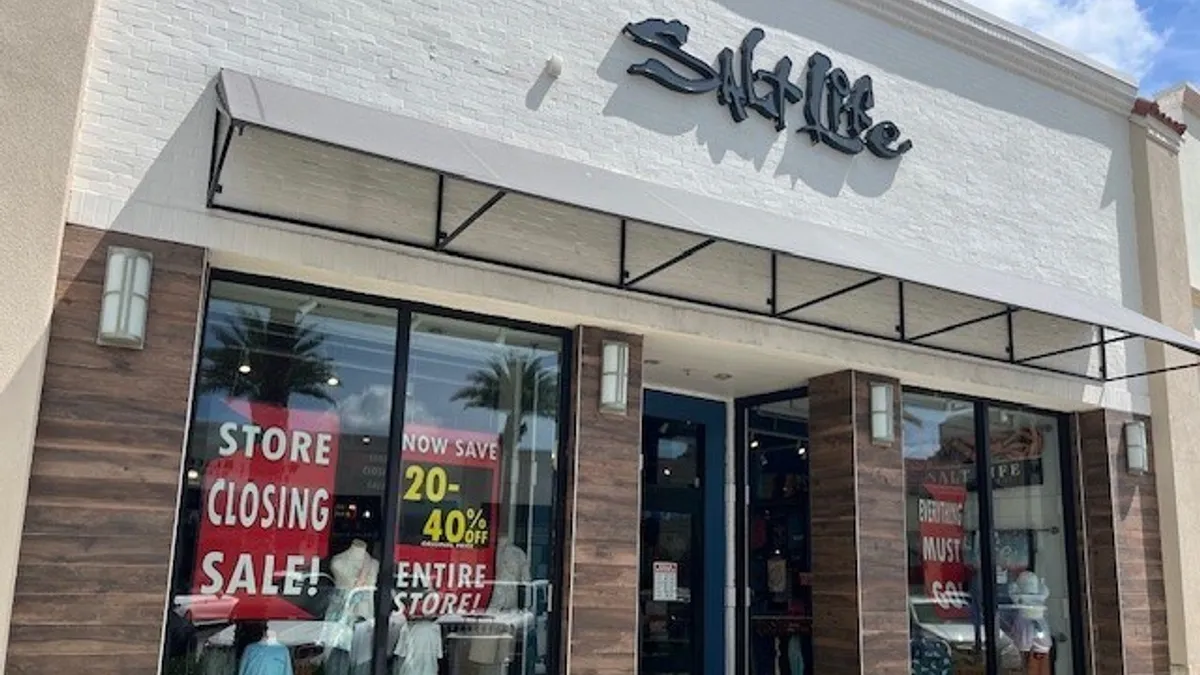Dive Brief:
- Delta Apparel Inc., parent company of the Salt Life active apparel brand, was sold through a court-sanctioned bankruptcy auction to brand management entity Iconix International and Hilco for $38.74 million on Sept. 16. The purchase includes the Salt Life brand and its related assets.
- Salt Life’s 28 retail stores in 10 states began liquidation sales on Friday, Hilco said in a Tuesday announcement. Hilco is also overseeing the sale of distribution center inventory and store fixtures and equipment. Iconix plans to pivot Salt Life to focus on e-commerce and wholesale.
- Delta Apparel filed for Chapter 11 on June 30 in bankruptcy court in Delaware. Court documents indicate the company reported $337.8 million in assets and $244.6 million in debts. Court documents also show the company’s top five creditors were collectively owed over $29 million.
Dive Insight:
The Salt Life brand began in 2003. According to a company history, two surfers in Jacksonville, Florida, got the words as a tattoo following “a shared moment of appreciation for what they called ‘the salt life.’” The design was recreated as a decal and put on T-shirts and hats.
It expanded into performance apparel, swimwear, sunglasses, bags, and accessories. The brand was organized around wholesale, e-commerce and company owned and operated retail stores. Salt Life also branched out into restaurants and beer.
But over the past two years, parent Delta experienced financial difficulties that led the company to scale back its operations. Those issues include declining liquidity and demand, Chief Restructuring Officer J. Tim Pruban said in court documents.
Cotton prices surged in 2022, resulting in increased costs. In response, the company decided to reduce production and source lower cost cotton. While that move did reduce costs, it also generated a one-time occurrence of expenses, including about $15 million in severance obligations, Pruban said. The company hoped to absorb those costs in 2023 but couldn’t due to diminished demand.
Last year, Delta initiated a cost savings plan that centered on reducing the company’s offshore manufacturing footprint from three countries to two and from six facilities to four. As part of that shift, the company moved its Mexico-based sewing and screen printing business to other countries in Central America, former Delta CEO Robert Humphreys said during a first quarter earnings call.
The company also initiated a sale-leaseback of a Tennessee distribution center, generating about $5.4 million in proceeds. Despite the success of the restructuring initiatives, “we were disappointed in our overall results for the first fiscal quarter of 2024, which as a reminder, is typically our slowest overall quarter due to the seasonality of our various businesses,” Humphreys said during the February earnings call. Humphreys resigned as CEO and board chair on June 29, just before the company’s Chapter 11 filing.
Delta’s net sales were $78.9 million in the second quarter of fiscal year 2024 compared to $110.3 million in 2023. Additionally, the company’s Q2 gross margin fell to 4.3% in Q2, down from 14.7% in the prior year. Pruban said a significant portion of that reduction was caused by unabsorbed production curtailment costs. The company reported a $33.2 million net loss for its 2023 fiscal year, which ended last September. The company employed just under 600 people before bankruptcy.
As a result of diminished liquidity, Delta defaulted on its pre-bankruptcy loan terms. Its lenders, in turn, decreased the funding they extended to Delta. At the time of its Chapter 11 filing, Bruban said the company had over $80 million outstanding on a credit agreement, but just over $2 million in cash on hand.
Correction: A previous version of this article misstated the amount of debts Delta Apparel owed when it filed for bankruptcy. Its debts totaled $244.6 million.













